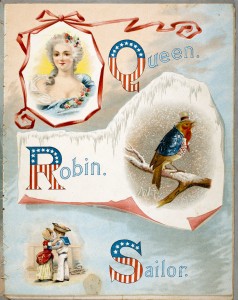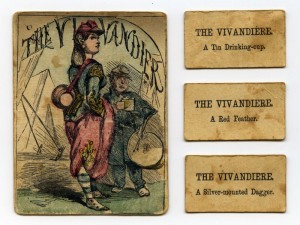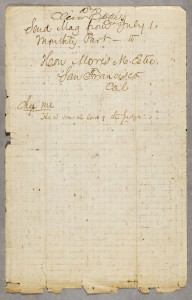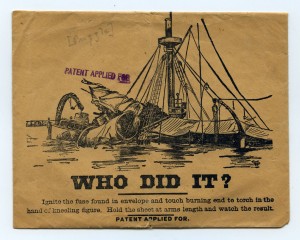Jennifer Burek Pierce, Assistant Professor at the University of Iowa’s School of Library and Information Science and recent AAS fellow, discusses the game “Who did it? The Maine Question” (described in an earlier Past is Present post) in the context of children’s games generally.
 In the array of AAS materials about young people’s play and reading, I’ve found a large number that depict militaristic and patriotic themes. Some displays are charming, sentimental evocations of activities children must have witnessed as the adults around them became enmeshed in the Spanish-American war and other military themes. The bright and colorful chromolithography used by the McLoughlin Brothers company filled alphabet books and puzzles with proud, patriotic children. Other companies advertised paper doll soldiers and remembered the Civil War with games like “A Visit to Camp”. In terms of books, magazines, and short stories, Oliver Optics’ works portrayed historic moments from the Civil War in The Soldier Boy; or, Tom Somers in the Army (the text of which is available online) to the outbreak of the Franco-Prussian war, when author W.T. Adams was caught abroad as fighting began. Click on the manuscript letter below to read what Adams wrote to his publishers.
In the array of AAS materials about young people’s play and reading, I’ve found a large number that depict militaristic and patriotic themes. Some displays are charming, sentimental evocations of activities children must have witnessed as the adults around them became enmeshed in the Spanish-American war and other military themes. The bright and colorful chromolithography used by the McLoughlin Brothers company filled alphabet books and puzzles with proud, patriotic children. Other companies advertised paper doll soldiers and remembered the Civil War with games like “A Visit to Camp”. In terms of books, magazines, and short stories, Oliver Optics’ works portrayed historic moments from the Civil War in The Soldier Boy; or, Tom Somers in the Army (the text of which is available online) to the outbreak of the Franco-Prussian war, when author W.T. Adams was caught abroad as fighting began. Click on the manuscript letter below to read what Adams wrote to his publishers.
Although it is popular to lament the passing of an era when children’s entertainments were far more innocent than they are today, the toys and games of this period were not free of risque and adult elements, despite what stereotypes of Victorian propriety and Progressive Era purity movements might suggest. 
 The McLoughlin Brothers’ puzzle, “Up the Heights of San Juan,” portrayed not only the Rough Riders’ charge but young men injured and dying in the grass. “A Visit to Camp” features both literal and metaphorical intoxication, as the characters visit the curvaceous Vivandier and experience her liquors and her charms. The didactic functions of games and literature –- intended to make learning enjoyable, through message-driven play — encapsulated multiple grown-up preoccupations of the day.
The McLoughlin Brothers’ puzzle, “Up the Heights of San Juan,” portrayed not only the Rough Riders’ charge but young men injured and dying in the grass. “A Visit to Camp” features both literal and metaphorical intoxication, as the characters visit the curvaceous Vivandier and experience her liquors and her charms. The didactic functions of games and literature –- intended to make learning enjoyable, through message-driven play — encapsulated multiple grown-up preoccupations of the day.
In this context, though, “The Maine Question” stood out. With its sheaf of thin papers, fuse cord, and illustration of what might have been seen as a sinister Spaniard, who appeared to be caught in the act of destroying the U.S. ship, this game struck a different character than many of the other military-theme games, toys, and stories for young people.



